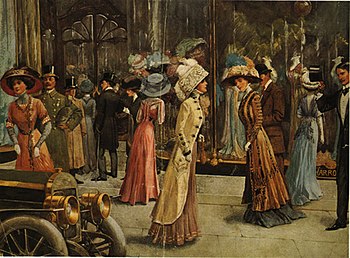 Throughout the years, women's fashion and design has always been influenced by history, politics, and location. A woman's status and station in society also affected the types of clothing choices deemed acceptable or expected of her. When taking a look at history, the role of the woman unfolds through popular clothing styles, as revealed through hemlines, layers of clothing, shoes, and overall fashion. Below you will find a collection of significant changes in women's fashion trends starting with the 1900s.
Throughout the years, women's fashion and design has always been influenced by history, politics, and location. A woman's status and station in society also affected the types of clothing choices deemed acceptable or expected of her. When taking a look at history, the role of the woman unfolds through popular clothing styles, as revealed through hemlines, layers of clothing, shoes, and overall fashion. Below you will find a collection of significant changes in women's fashion trends starting with the 1900s.During the 1900s, legs and feet of the woman were rarely seen (unless in the sitting position). This meant that stockings, shoes, and other footwear didn't gain much attention. Clothing and shoes of the time highlighted silk bows, small buckles, and dark colors. Pointed toes and a moderate high heel were in fashion. Women's skirts became narrower after the Civil War and displayed more of a cone-shape rather than a bell. Clothing was heavily starched and "shirtwaists" became the latest style, which were fashioned after men's shirts.
In the 1920s, legs became an asset and showed through the kind of clothing worn during this time period. Hemlines rose and women began to take great interest in flesh-colored stockings and shoes. The expensive silk stocking accompanied evening wear, while ribbed and patterned selections (diamond-cut) became the rage. "Flapper" fashion took over with the Roaring 20s, highlighting floating fabrics, handkerchief hemlines, and girdles.
When the 1930s arrived, women's fashion took a turn back to portraying a more "ladylike" appearance. The clothes were feminine in style - crisp and clean during the day and glamorous by night. More sophisticated shoes emerged, including the strappy open-toed sandal. Additional features of the decade included short-fitted suits and jackets, the "little black dress," and the introduction of nylon.
In the 1940s, World War II took a toll on women's fashion, as leather shoes lessened and certain fabrics were limited. Heavy wooden soles and wedge heels became commonplace. A host of clothing items were rationed - bought using a "coupon" system. Some of the non-rationed items included mending wool, ribbons, lace, suspenders, and clogs. Women began painting their shoes with bright colors or decorating the sides of the soles with small shells or studs to elevate their sense of style.
During the 1950s, glamour took over and it showed in the latest women's fashion designs. Full skirts with petticoats, swoop-line empire dresses, and fancy suits became popular. Many women now wore a stiletto heel and Italian shoes (known for ultra-elegance and refinement). Seamless stockings and beehive hairdos accompanied the clothing of the 50's.
The 1960s brought more freethinking attitudes of the world, including fashion. Skirts became much shorter - leading to the creation of the "mini." Stockings were tossed to the side and pantyhose made an impression on the women of the 60's. Flat boots were worn with very short dresses. Additional fashion introductions of the 60s included psychedelic fabric prints, denim jeans, and the pill box hat. Shoes became chunkier, displaying thicker low heels with rounded or squared toes. Buckle shoes were quite "in" with matching gold or silver heels to match the buckles.
Stop by to see a wide variety of beautiful Red Hats Pink Hats, Red Hat Merchandise, and Jewelry that is just perfect for Red Hat Ladies. Be sure to sign up for free coupons and sale notifications too!
Article Source: http://EzineArticles.com/?expert=MaryLu_Jones
No comments:
Post a Comment